Good company in a journey makes the way seem shorter. — Izaak Walton
Vivasayee /ʋɪʋəsɑ:ji/ विवसायी
விவசாயி
Tamil
Noun.
1. Farmer
The occasion of Pongal seemed like an appropriate time for me to give you guys an update of the goings-on at the farm my parents, Noushadya and I have been spending the last 6 months at.
Caution : ~20 minute read. Using a laptop or a tablet is advisable. Photos will look better 🙂
Between September ’17 and May ’18, I volunteered at two organic farms located at Auroville near Pondicherry – Solitude Farm and AuroOrchard. As I spent those 6 months there, I realised that this was a cause worth spending time on full time.
The cause being – Reducing my carbon footprint and environmental impact on earth. The fact that a sustainable lifestyle is a healthy lifestyle was also a definite motivation. And so was, escaping consumerism.
After a lot of introspection & contemplation, search & debate, we registered acquisition of agricultural land on 10th July 2018 at Vickramasingapuram in Tirunelveli district, Tamil Nadu. In December 2017, we started our search from Kadayam, my appa’s birth place, 15 kms from the land. The primary factors behind the search was price of land and water availability.
Out of the 11.5 acres land purchased, we started our practice of regenerative sustainable agriculture with just one permanent employee + help of family members on 5.5 land portion (boundary length ~750 metres). This farm is located near the tourist town of Papanasam in Tirunelveli district – just 2.5 kms away from the famous Sivan temple. History says, the land was primarily comprised of grazing lands and rice fields. There is also a small coconut orchard with a little biodiversity introduced near the well by the farm owner prior to us. The farm is next to the forest Kalakad Mundanthurai Tiger reserve.

Coconut trees aren’t yielding much because of the last 2 low rainfall years. We need to revive them now that drip irrigation has been completed for these trees
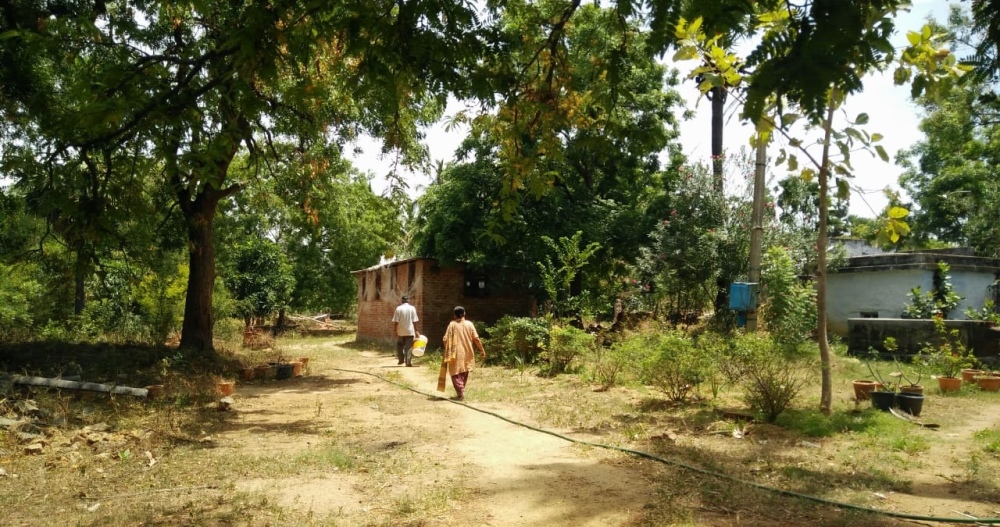
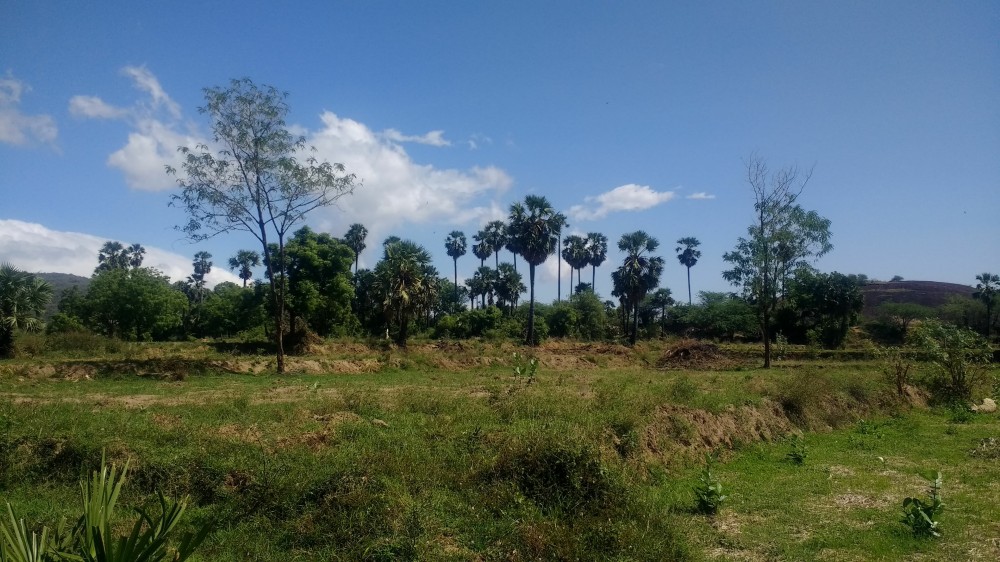
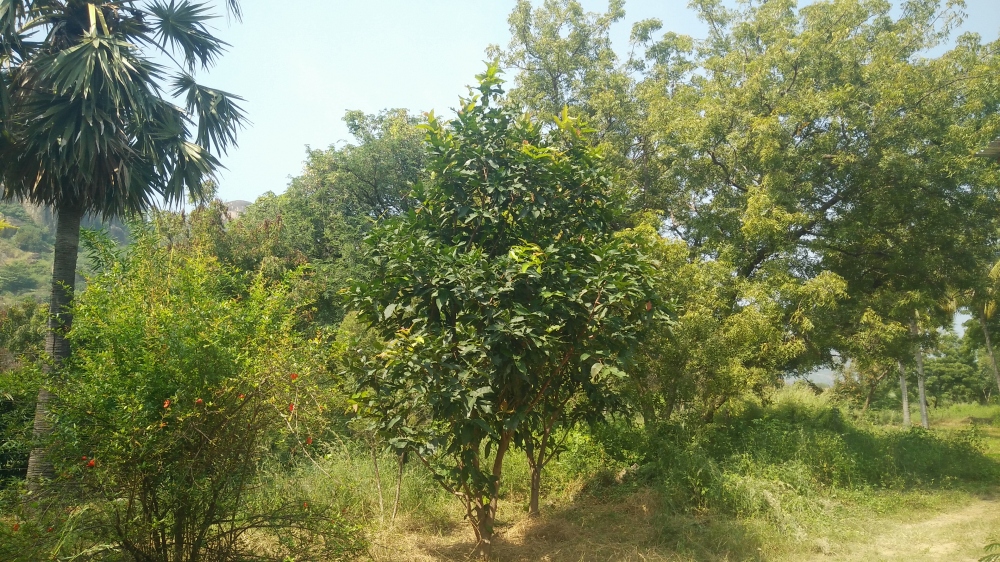
The top soil is mostly clay, but a foot below is red soil. This is mostly from the silt deposited by farmers before us from the nearby pond to enable water stagnation in rice fields. The heritage owners of this land were Konaars. A few of the family members still farm and graze on nearby fields. So, the farm, prima facie, sounded like a good place to grow a diverse set of crops, which was one of the primary factors in choosing this land. Other than, obviously, WATER.
Irrigation is primarily from a well in the farm and a north east monsoon rain fed pond along the northern side of the farm. The groundwater level in this area is good because of the proximity to origin of Thamirabarani river, one of the few perennial rivers in Tamil Nadu. The pond only provides water between November and February though. With drip irrigation, rainwater harvesting/preservation techniques and without too many water intensive crops such as rice, banana and sugarcane, (monocrops of which I will never do ever) the water in the well will suffice for the entire year for the 5.5 acres we have fenced. Because there are no factories nearby and very little human civilization around, I am confident the water in the well is very clean. We need to do a water quality test – we were waiting for the monsoon to end, lest the rainwater interfere with the groundwater’s quality evaluation.

Pond before north east monsoon



Features. Other than the pond in the north, there’s a stream which runs only during monsoons. This happens when the pond overflows or there is a steady stream from the western ghats. This stream runs along the south fence for ~200 metre (out of a total of 750 metres). There is a 0.5 acre unutilized pond right outside the fence in the east. This pond stands on common government land and another private owner’s land. If we can barricade along the circumference before next monsoons, we can have a pond closer to the farm. There is a range of hillocks south of the fence where you spot most of the wildlife.
Structures in the farm include a cow shed, a chicken coop, a store room and a tiny shed, which might have been used in the past as a 1 or 2 person accommodation. We are planning to build the house alongside the tiny shed, and are thinking of converting the chicken coop into a volunteer house.
After purchasing the farm, the first thing we focused on was building the fence to keep wild animals from destroying crops. After a lot of deliberation, we decided to go for a Solar Electric Fence. For people in the unknown, in this system, the battery gets charged by a solar panel and another unit sends a short pulse every second to deter any animal or even humans from entering. We had to level the land and cut trees in the way of the fence. The preparatory work took a week, instead of 3 days, delayed because of the sudden rain onslaught brought by Cyclone Gaja. Installation of the fence got completed in the first week of October for protecting against wild goats (probably Nilgiri tahr), wild boars, sloth bear, gray langur – footpaths of all and droppings of a few we had seen. Barring the langur, the 3 were daily early morning visitors to the farm.

We have also heard of tigers and leopards roaming nearby in the hills, obvious given the proximity to Kalakad Mundanthurai Tiger reserve.
There is still a little risk of animals climbing from the trees in the south part of the fence along the stream from the unoccupied land. It should be hopefully occupied soon – some discussions are on between the current owner and a prospective buyer in a town called Ambasamudram, nearby. After putting up the fence, peacocks remain the only menace which might eat away a lot of the vegetable and grain produce – We are yet to install bamboo pandals in almost 1 acre of farm and wrap them with fish nets probably to keep them away. There are 2 gates that serve as entrances – one main gate, with vehicular entry, from the east via the coconut orchard and another pedestrian gate to walk towards the pond in the north.
We planted ~350 timber and fruit trees in October and November during the north east monsoon.
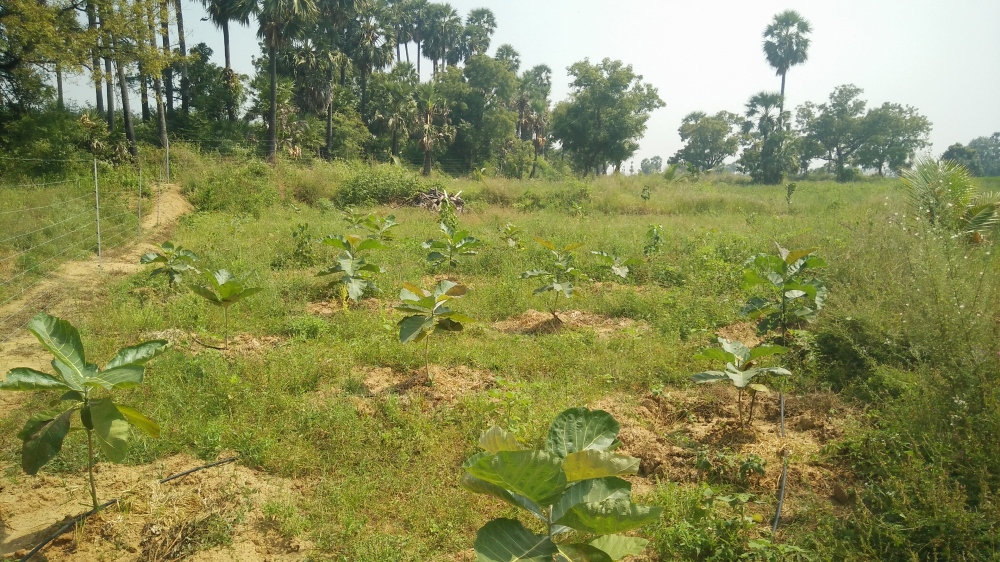
We transplanted 1 acre of rice on 21st November – 100% organic cultivation – hybrid seeds and conventionally tilled flooded cultivation though.
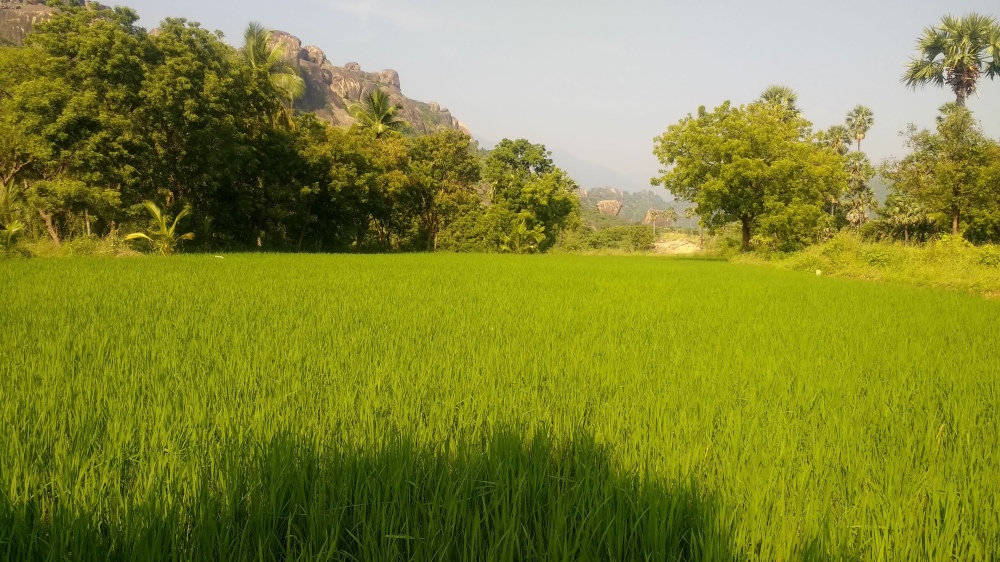
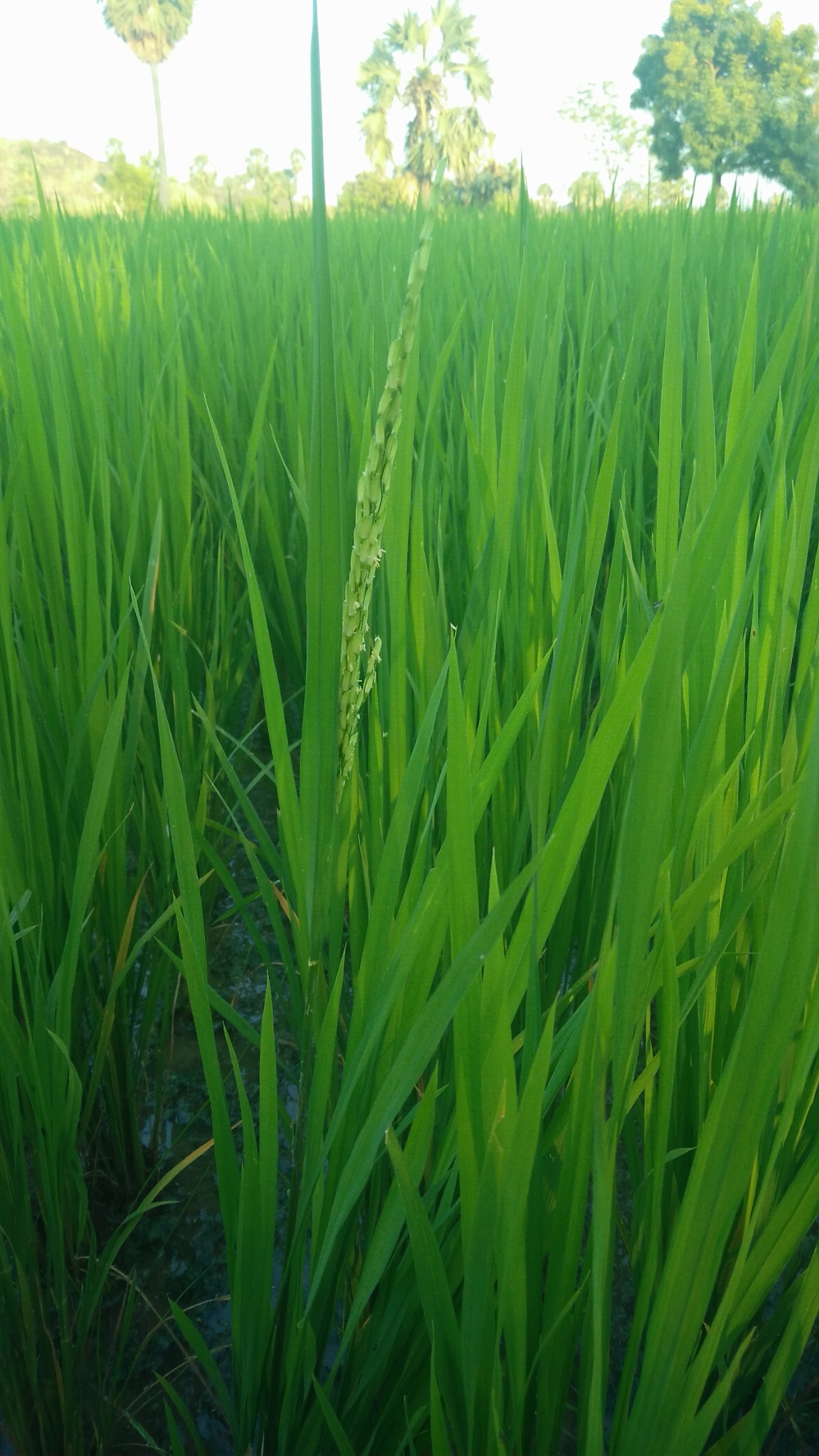
For green manure and mulch, glyricidia, Mexican sunflower, Subabul planted so far. We have planted chiefly Teak (total of 60) and Subabul along the fence. We are using malai vembu (200+ trees planted) and Subabul (1800 tiny saplings) as windbreak by planting them in High density – 6 ft and 2 ft spacing respectively . We got these saplings from a paper company called TNPL at a subsidized rate – I don’t have a contract to sell it back to them as pulpwood as such. I plant to keep these trees permanently. 🙂

We tried our hand at cultivating palm sprouts, which are a delicacy in the Tamil Nadu and Sri Lanka They are sold during Pongal at local markets and by the roadside for 3 bucks a piece. From the ~50 palm trees, palm fruits start falling when they mature. Each fruit contains either 2 or 3 seeds . Before putting up the fence, sloth bears would enter the farm and chew all palm fruits, leaving just the seeds for us. Now, that’s nature’s way of helping us! The germination of the seeds is faster in this condition. During the last 3 months , all of us here together (appa, amma, Noushy, Sesaiyya and me) must have collected more than 500 palm fruits – equivalent to ~1500 palm seeds.
If you don’t collect palm fruits in your farm to make them germinate at one place, they will germinate all over the farm and start growing into palm trees they don’t need much water once they have taken root.
In the coming year, we will hire a few people to climb and harvest palm fruits on a single day. Collecting them daily for a 3-month period is too painstaking a process.
We collected 15-20 kg Neem seeds (mostly appa and amma 🙂 from ~50 Neem trees in the farm during the lean August September period for use as a natural pesticide for the entire year. We crush the Neem seeds by hand a day before we need to spray Neem Seed Kernel Extract, one of the most potent pesticides knows to mankind . Google it – Quite impressive the diversity of pests it can control potentially. There are a few exceptions, of course. We soak the crushed seeds overnight before spraying it with a 12-litre battery-operated sprayer we have at the farm. We use NSKE for all crops, including rice. The other natural pest repellents we have tried is the Ginger – Green Chilli – Garlic solution and Citrus solution.
Drip irrigation for approximately 500 trees was installed in the month of December – 200 Malabar neem (malai vembu in Tamil) + 100 other native timber trees, 80 coconut, 60 citrus (lemon, citron and amla) fruit trees and 40 other fruit trees. We have installed a sprinkler system for 0.25 acre of vegetables – mostly for self-consumption and distribution to family / friends. A 30 feet radius Sprinkler has been installed to irrigate Subabul in a plot. A drip irrigation technician who is a resident of Tirunelveli was hired on a daily wage basis for 6 days for the installation above. Cost incurred for the entire 5.5 acre was ~₹70k. No more annual costs, I foresee, for irrigation per se.
The only permanent employee (Sesaiyya) is an experienced farmer – he owns 0.5 acre of land where he grows monsoon crop of rice every year and another crop if the south west monsoon favours this place. No borewell or well installed anywhere near his farm. He is 67 years, though. So, he takes more time to complete certain jobs and takes too many leaves – but does every job to perfection. As for the moment, till we move into the house at the farm, I think. We have employed people on a daily wage on requirement basis.
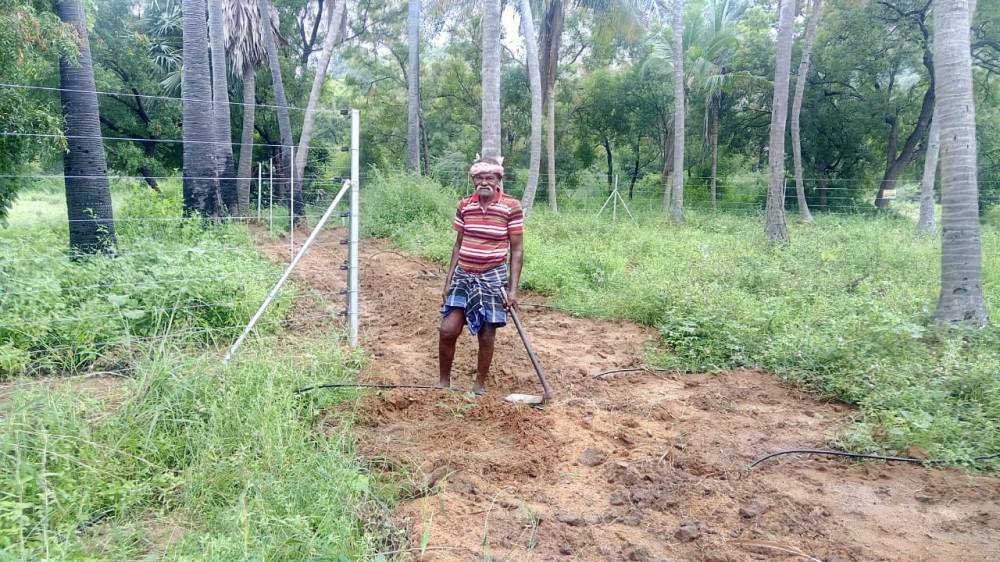
The only revenues from the farm so far have been sale of firewood, mango harvest, coconut harvest and curry leaves.
The focus is not going to be on any income generating daily activity for the next 3 months at least. The focus is only on building soil health and self sufficiency for now.
We are self sufficient in 80% veggies, 100% greens (including edible weeds), coconuts, mangoes, curry leaves, hibiscus flowers for juices, tulsi, karpuravalli, basil, mint for now. The vegetables we have tried our hand at so far are ladies finger, cluster beans, pumpkin, cucumber, brinjal, tomato, cherry tomato, wing beans, long beans, gongura.


There are grown mango, pomegranate, guava and sitaphal trees, which are producing fruit. The fruit trees we have planted so far are jackfruit, guava, pomegranate, jamun, nellikai, ara nellikai, mosambi, chikoo, orange, which should start yielding in 3-5 years. The timber trees that we have planted this year are Teak, Mahogany, Indian Rosewood, Poovarasu and Malabar Neem.
The idea is to first become a self sufficient farm for all fertilizer and pesticide requirements before we become self sufficient in food and energy needs.
I have purchased in the past a few bio fertilizers and bio pesticides, which I want to avoid in the future.) Instead of focusing on increasing revenues from the farm, I want to first focus on how I reduce my cost of living by living off the earth.
It’s been 6 months since we started on this journey. There is a long way more to go! We plan to buy a native breed of cow (for home’s dairy consumption and for use of manure to prepare Jeevamrutham and compost) in the next couple of weeks and we also want to start beekeeping in the next 6 months. We want to start building a house in the next 2 months with solar as electrical energy source and biogas as cooking energy source. The plan is to grow green manure for 2 months in an additional 1 acre to add lots of organic matter in the soil before converting it to a vegetable garden. We intend on planting 50+ more trees approximately in the next 3 months in another couple of small plots distributed around the farm. We want to grow urad dal after rice in crop rotation. We want to do native varieties of rice and millets next monsoon, along with more tree planting. Organic certification has to be initiated in the next couple of months to help us market the produce. We want to have 2 small ponds in the farm by this year-end – one large JCB dug and one small hand dug. We also want to try our hand at pickles, edible oils, baked snacks as few of the value added products in the next year.
Tulsi grows here in abundance in the wild. For now, we’ve named the farm Brindavanam.
Lots of stuff to do. Join us for a weekend or more. Noushadya and I would love to meet like minded people, who would also like to join this initiative full time or as a volunteer at the farm. Community based living can be tried out too, provided we find the right match. More the merrier. We have rented a house 2.5 kms away from the farm for now and have space to host a few people at a time. Maybe before north east monsoon hits this year in October, we will have a house built at the farm itself.
Visit the contact page to get in touch with me or visit our place
Come over. Good food, music (guitar, djembe and flute) and star gazing might be on order 🙂 😀
For those who don’t know me : I am Sudhakar. I was born and brought up in Mumbai. Travelled for work to Bengaluru, Munger and Kolkata. Pursued my education in Rourkela and then Mohali. Passionate about food, earth, sustainability and music. I can speak in Tamil, Hindi and English fluently. Spent my corporate life in ITC and then in Housing.com. Spent my student life at NIT Rourkela and then ISB. Spending my farmer life at Village Arunachalapuram, Taluk Ambasamudram, District Tirunelveli, State Tamil Nadu.
Noushadya is a Thanjavur girl. She studied at SIMC before pursuing a career at Milaap, a crowdfunding platform based in Bengaluru. She is a passionate cook and an aspiring baker. She is my full-time partner in this endeavour and in life.

Really I will share your journey of life as vivasayee to my relatives and friends. Hope you and Noushy have a best life with full of fun and prosperity
LikeLiked by 1 person
Hey Sudhakar – Very nicely blogged ~ thats one inspiring story man! cant wait to visit your farm and get our hands dirty! lets build the volunteer shed soon… 😉
Looking forward for more leg-pulling 😉
LikeLiked by 1 person
Thank you! Will let you know once the house building starts. The plan now is to have a guest room in the house instead of a separate volunteer shed.
LikeLike
Yo Sudhakar! Very amazing stuff. Keep it going and all the very best.
LikeLike
This is really awesome. Keep it up!!! … Here’s one to the crazy ones 🙂
LikeLike
Hey Sudhakar, buddy you are living the post retirement life I am planning to live. Wish you a healthy farm life.
I am in Bangalore. Let me know how can I contribute 🙂
LikeLiked by 1 person
This is amazing Sudhu! So proud and inspired! Let me know if I can help in anyway.
LikeLiked by 1 person
Will do, bro!
LikeLike
Amazing! I’m one of your juniors from NIT Rourkela. Is it OK if I come visit some time?
LikeLiked by 1 person
Sure, Shishir. Any time after 18th February should be fine. Please call/whatsapp me on 7718871501 before planning your visit.
LikeLike
Commendable move Sudhakar……
The Story should be shared with monday morning. Many would find it inspiring.
LikeLiked by 1 person
Good job sudhakar. So much achieved in such a short time.
LikeLiked by 1 person
Thank you! Please help me spread the word 🙂
LikeLike
Maddu, proud of you!!! I always share your story with everyone I know and keep saying he is my friend with whom I studied in NIT Rourkela! Keep up the good work and best of luck! Hope I can come and visit the farm sometime soon 🙂 My best to Noushadya as well!!!
LikeLiked by 1 person
Thanks a lot, Ravi! Please do visit whenever you are down to this part of the world 🙂
LikeLiked by 1 person
Hi, it’s me Hidayath Ulla.
It’s fantastic to know your marvelous and innovative journey towards a visionary change.
It’s great to have worked with you for a small instinct. Really it’s a aspiring blog. looking forward to meet you soon. All the best.
LikeLiked by 1 person
Thanks a lot for the wishes, Hidayath! How have you been?
LikeLike
I am fine, Thank you for remembering me.
LikeLike
Very inspiring.. Hats off to you Sir
LikeLiked by 2 people
🙂
LikeLike
Very inspiring.All the very best to all of you.
LikeLiked by 1 person
Thank you, athai! 🙂
LikeLike